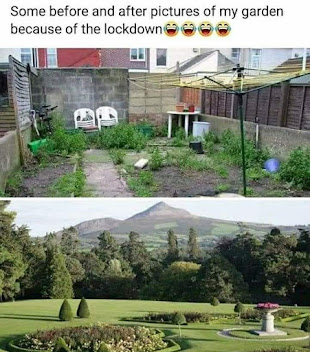Like the 20 million other new gardeners this last year, gardening has been very therapeutic for me during covid. Here are some highlights.
Starting with a blank slate (summer 2020)
We decided to replace our mostly brown lawn with fruit trees and drought tolerant plants. Dad tilled up this area in just 1 hour!

We used the sheet mulching method to kill off any remaining weeds and lawn: we laid down cardboard and placed 3 inches of compost and mulch on top of the cardboard. The cardboard will eventually break down into compost and replenish the earth with carbon and nutrients. If you use this method, remove all tape and only use cardboard with no color ink.

We felt it was more organic to use cardboard than landscape fabric. But we'll see if I feel the same way in a year or two when the weeds are back.
We have a large camphor tree which makes it hard to plant anything else. Camphor tree roots are notoriously aggressive, breaking up concrete and stealing water from other plants! So we will be sinking 25 gallon pots in the ground and planting (citrus) in there to protect the plants.
Work in progress, stay tuned!
Succulent garden
I discovered these sculpture like plants while on a drive (if you are ever wondering who the stranger taking photos of your plants is..), which
my plant app identified as artichoke agaves. I later found some being sold for a steal on craigslist! The only catch was that they were very heavy and extremely thorny - we used a combination of ropes, a ramp, and cardboard to roll them from the car to our yard.
Here they are planted. Aren't the artichokes beautiful!? You will also see some kalanchoe paddle plants. I love plants with dramatic leaves, and used a mix of blue, red and green leafed plants for this area.

Check out this adorable frog my friend got for my bday! Namaste!

Clay soil: a gardener's worst nightmare
We have a small south facing patch with direct sun, which made it a perfect spot for fruit trees. But it was mostly being taken up by another beautiful camphor tree...
whose roots were so invasive, that they were breaking up the driveway
so the tree had to go.
It took one tree pruner, 2 stump grinders, and 20 hours of sifting out rocks and mixing in compost to turn this rocky, root filled clay soil, into plantable soil. Gardening was different from what I imagined.
And I now own a growing rock collection that I neither need nor want.
We also removed an old orange tree here, that was experiencing dieback no matter how much we watered or fertilized. When we dug up the tree, we found the culprit. Do you see that orange colored root in the below photo? That is a camphor root that traveled 15 feet and grafted itself under the orange tree base, cutting off half the orange roots. That camphor tree was no joke!!
The orange tree was still producing fruit though, so we gave it to someone who could give it a better home.
When we ground down the camphor tree stump, it produced 2 truckloads of shredded wood, which was useful mulch for the new garden! Mulch is any material that is used to cover soil and helps with water retention. Never leave soil uncovered! The sun will destroy the quality and structure of your soil. The best soil is crumbly in texture. You can also use compost as mulch. Mulch will break down into compost anyway after a year or two. Do not place wood mulch within 3 feet of a home because it can attract termites.
We finally mixed in compost and chicken manure to add nutrients to the very nutrient depleted soil, and topped off with 3 inches of... mulch!
We also replanted a row of lily of the nile plants. The lilies were so old, that they had developed a large mass of unnecessary roots, raising the plants a foot above ground level. In this photo, you can see the plants we de-rooted on the right, and the plants we still had to remove on the left.
Apparently, you are supposed to divide lily of the niles every 5 years.. oops!
This patch now has loquat, honey mandarin, and lychee trees, each 6 feet apart. Loquats are popular sidewalk trees, because they are evergreen, ornamental, and have delicious fruit. As for lychee, it would have been hard to grow this tropical tree 20 years ago, but thanks to climate change (booo!), the weather is now hot enough.
I usually buy small 5 gallon trees/saplings, but you should buy the biggest tree that you can afford. The benefit of buying a small tree though is that you can keep it small and
prune into your desired shape when a plant is young. Below is a photo of the small fruit tree culture.
Growing our own food for the next apocalypse
Dad built a raised veg bed, by stacking up 4 layers of brick. We did not cement them. We put chicken wire on the bottom to prevent gophers, lined it with cardboard, and then put compost in.
A year later, we (I) changed our mind and decided to remove the bed and plant veggies directly in the ground so that we have more flexibility and space. (Sorry Dad!)
Add a soaker hose, and look at those veggies grow! Tomatoes, radish, okra, zucchini, magic beans! We planted marigold and onion seeds around the perimeter to prevent pests and insects. I also will stake the tomato plants instead of using cages.
We made teepees out of branches from the camphor tree that we cut down. The teepees will eventually be covered in green bean stalks. And we planted blackberry bushes on top of the retaining wall, so that they trail over. I can't wait!
We've been mixing in chicken manure (from home depot) when planting anything. This is a great natural fertilizer which adds nitrogen back into the soil. You can also use manure from cows, sheep, etc..
Preparing to start my smoothie franchise
I started with 1 fruit tree a year ago.. and ended up with 30 trees, 8 berry plants, and 3 vines (kiwi, passionfruit, grape)! I'm a fruit tree addict! We are not going to let any of them grow taller than 7 feet. Backyard orchard culture/high density planting is for people who want a variety of fruit and just enough fruit to eat.
The first tree we planted was a fruit salad tree. Our family friend gave me a gift card to a local nursery and asked me to plant a tree in Mom's memory. I chose a fruit salad tree, because I know Mom would have gotten a kick out of it, as it makes for a great talking piece. This fruit salad tree has 4 grafted branches on one tree! Peaches, nectarines, plums, and apricots! Note how the blossoms are different on each branch.

Under the fruit salad and multi-cherry trees (4 types of cherry grafted on one tree), I created round beds and planted companion plants. Companion plants are synergistic plants that are beneficial to each other i.e. onions and nasturtiums deter pests under cherry trees.
We topped off the beds with mulch to help with water retention. Within a month, the texture of the hard clay soil improved so much, that I was seeing earthworms moving in! The downside was that there were grubs moving in too. I sprayed the ground with neem oil mixed with water and dishwashing liquid for a natural insecticide, and overturned as many grubs as I could to let the birds have at them.
Mission fig and tiger fig trees planted in the same hole - an example of high density planting.
After 6 months of digging holes and breaking pipes, I realized I needed help so I roped in my gardener.
He is awesome and is the same person who cut down our camphor tree in 20 minutes with a machete!
Here he is cutting down another tree to make way for 2 banana trees.
We planted a dwarf cavendish and an ice cream banana, which apparently produces blue bananas which taste like vanilla ice cream!
Planning
I spent a year planning before planting anything in the ground. Even when I planted initially, I sunk pots into the ground so it would be easier to move, if I changed my mind!
Here was my plan, created in google docs:
As you can see, there's still a lot more to do. If you made it to the end of my post, I owe you a fruit basket! Thanks for reading, and Aloha for now!










































No comments:
Post a Comment